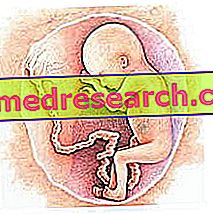The main products deriving from the digestion and intestinal absorption of carbohydrates are glucose, galactose and fructose. These sugars reach the hepatic capillaries through the mesenteric vein and the portal vein, where they are retained in large quantities.
It is precisely in the liver that galactose and fructose are converted into glucose, which in practice represents the only sugar present in the circulatory stream. The term glycemia is used to indicate its concentration in the blood. In a healthy person, this parameter fluctuates between 80 and 100 mg / dl on an empty stomach. In order for the individual to be healthy it is essential that the blood sugar remains relatively constant during the 24 hours.

The importance of glucose circulating in the blood is linked to the inability of neurons to draw energy from other energy substrates, such as fats and amino acids. Signs of cerebral distress already manifest themselves for glycemic values lower than 60 mg / dl and are responsible for the typical symptomatology previously illustrated.
When the blood sugar rises too high, reaching the threshold value of 180 mg / dl, the body begins to lose glucose with urine (glycosuria). This, which at first glance might seem to be an effective defense mechanism, is actually a dangerous phenomenon, since for osmotic reasons the urine containing glucose attracts a lot of water, with consequent dehydration of the body.
In physiological conditions the glycosuria is equal to 0.
When sugars absorbed from the intestine enter the liver through the portal vein, they can suffer different fates.
First of all, they can be degraded by liver cells to draw the energy needed to meet the metabolic demands of hepatocytes.
Glucose can also be converted into glycogen, which is the body's sugar reserve. A certain altitude can also be transformed into triglycerides.
The fate of sugars is heavily conditioned by the nutritional status of the subject.
-In response to a meal particularly rich in carbohydrates the liver tries to bring the blood sugar back to normal:
1) converting its metabolism, normally based on the oxidation of fats, with the aim of consuming mainly sugars
2) increasing glycogen deposits in hepatocytes
3) promoting the conversion of glucose into fatty acids
PLEASE NOTE: glycogen, which is reduced in the individual glucose monomers during fasting, can be stored in a maximum of 5-6% of the hepatic mass (about 100 grams). When these stocks are saturated, the liver is forced to convert the excess sugar into reserve fat tissue. For this reason, a diet low in fat and rich in carbohydrates (pasta, bread, cereals and derivatives, sweets, etc.) is not effective in promoting body weight reduction.
The liver regulates blood sugar also through the intervention of various hormones; the most known and influential are called, respectively, insulin and glucagon.
The regulatory action on glycemic values is not entrusted solely to the liver; in the same way, insulin not only acts on hepatocytes but also affects the metabolism of various tissues. In the muscle, for example, this hormone promotes the entry of glucose which, in addition to being degraded with glycolysis, is transformed into glycogen storage.
Insulin also acts at the level of adipose tissue, increasing glucose uptake and stimulating its deposition in the form of triglycerides.
CONTINUE: Carbohydrates and hypoglycemia »



